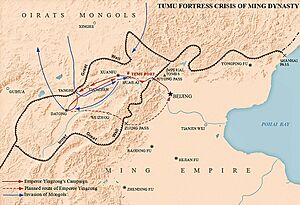Tumu Crisis facts for kids
Quick facts for kids Crisis of the Tumu Fortress |
|||||||
|---|---|---|---|---|---|---|---|
 |
|||||||
|
|||||||
| Belligerents | |||||||
| Northern Yuan, Oirat Mongols | Ming dynasty | ||||||
| Commanders and leaders | |||||||
|
|||||||
| Strength | |||||||
| 20,000 | 500,000 (thought to be an inflated figure) | ||||||
| Casualties and losses | |||||||
| 2,000 | 400,000 | ||||||
The Crisis of the Tumu Fortress (simplified Chinese: 土木堡之变; traditional Chinese: 土木堡之變), also known as the Tumu Crisis (simplified Chinese: 土木之变; traditional Chinese: 土木之變; Mongolian: Тумугийн тулалдаан), was a major battle that happened on September 1, 1449. It was a conflict between the Northern Yuan and the Ming dynasty in China. During this event, the Oirat Mongol leader, Esen, captured the Chinese Emperor Yingzong of Ming. This was a very surprising and important moment in history.
Contents
The Tumu Fortress Crisis: How It Began
In July 1449, Esen Taishi, the leader of the Oirat Mongols, started a big invasion of the Ming dynasty. He attacked with his ally, Toqtaq-Buqa. Esen himself led his army towards a city called Datong in August.
At the Ming court, a powerful official named Wang Zhen was in charge. He convinced the 22-year-old Emperor Yingzong of Ming to lead his own army into battle. The Ming army was put together very quickly. It included 20 experienced generals and many high-ranking officials. Wang Zhen acted as the main commander.
The Ming Army's Difficult Journey
On August 3, Esen's army defeated a Ming army near Yanghe. This area was just inside the Great Wall of China. On the same day, the Emperor made his half-brother, Zhu Qiyu, the temporary ruler.
The next day, the Emperor left Beijing. His plan was to march west to Datong and then return to Beijing. The journey started with heavy rain, making it difficult. At Juyong Pass, some officials wanted the Emperor to go back to Beijing. But Wang Zhen said no.
On August 16, the army saw the sad sight of the battlefield at Yanghe, covered in bodies. When they reached Datong on August 18, reports from local commanders made Wang Zhen realize it was too risky to go further. So, on August 20, the army started to head back to the Ming capital.
Wang Zhen's Decisions and the Disaster
Wang Zhen made a strange choice for the return journey. He was worried that the soldiers might damage his family's lands in Yuzhou. So, he decided to take the same dangerous route they had come from.
On August 27, the army reached Xuanfu. On August 30, the Northern Yuan forces attacked the Ming army's rear. They completely destroyed it. Soon after, they also wiped out another group of cavalry led by General Zhu Yong.
The Battle at Tumu Fortress
On August 31, the Ming imperial army set up camp at a place called Tumu. Wang Zhen was advised to move the Emperor to the safety of the walled city of Huailai. This city was only about 45 kilometers away. But Wang Zhen refused.
Esen sent a group of his soldiers to cut off the Ming army's access to water. By the morning of September 1, the Mongols had surrounded the Ming army. Wang Zhen would not try to talk or negotiate. He ordered the confused Ming soldiers to move towards the river.
A battle started between the disorganized Ming army and Esen's advance forces. The Ming army quickly fell apart and was almost completely destroyed. The Mongol forces captured many weapons and armor. Most of the Ming soldiers were killed. All the important Ming generals and officials died. Some stories say that Wang Zhen was killed by his own officers. The Emperor was captured, and on September 3, he was taken to Esen's main camp.
What Happened After the Crisis
Esen hoped to use the captured Emperor to get a lot of money and a good peace deal. He also wanted better trade benefits. However, his plan did not work out. This was thanks to the strong leadership of the Ming commander in the capital, General Yu Qian.
The Ming leaders refused to pay for the Emperor's return. Instead, they made Zhu Qizhen's brother the new emperor, known as the Jingtai Emperor.
The Ming never paid a ransom for Zhu Qizhen. Esen finally released him four years later, after getting a small trade agreement. Zhu Qizhen was allowed to return to Beijing. But he had to agree to give up his claim to the throne. He was kept under house arrest in the Forbidden City.
Esen faced more and more criticism because he failed to get more from his victory over the Ming. He was killed in 1455. Zhu Qizhen later took back the throne in 1457. He did this by removing his brother from power in a military takeover.
See also
- Defense of Beijing
- Battle of Yehuling
- Battle of the Kalka River

